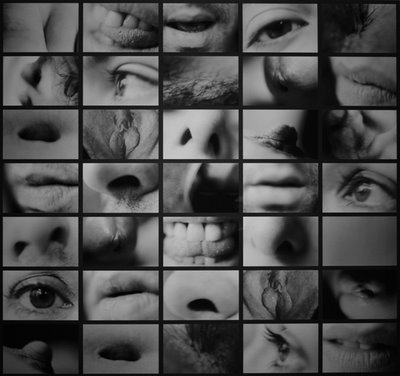Carolee Schneeman speaks

Carolee Schneemann spoke about her life and work at Harvard on Oct. 9. Here’s some things she said:
- The importance of “Maximus at Gloucester” [pictured above] is not just that it incorporates lobster traps and debris collected while taking a walk with the poet Charles Olson. … The poet had been such an immense influence to [my lover] James Tenney and to me in relationship to his concern for deep imagery, sustained metaphor, and also that he had been researching Tenney’s ancestors that landed at Cape Ann [Massachusetts], which Tenney, generations removed, hadn’t even known about. So that was very magical. We went on my birthday, Oct. 12, in the ‘60s. And Olson had welcomed us. He was happy that we were there. We slept in what was the Tenney graveyard, near Gloucester. And walking with the great man he asked me what I did. And I said, “I’m a painter and I’m using dimensional elements and even movement and speech.” And Olson, who was about 6’ 6”, hulking, shook his head, and said, “Well, you probably don’t remember, but when the Greeks let the cunts begin to speak, theater was destroyed.” And I thought, “Oh, this is something important.” Amid all the other resistances, here’s my cultural hero telling me again, “You can do whatever you imagine you should do, but don’t expect us to respect it. And maybe, maybe you have to shut up.”
- My sense was to use the body, my body, as a collage element, entering into the constructed, built material. But what happened was the reverse: the body began to dominate. … It always tended to escape its position as a collage element and to dominate what I was building.
- My question at the time was: Can I be both image and image-maker?
- When photographs of my body were taken to curators that I thought might be interested or sympathetic I was told without exception, to a man, they were all men, that the work was exhibitionist and narcissistic, and, if I was really a painter, to get my body out of there.
- When I was teaching at New Paltz, when I was teaching film, a guy came in from buildings and grounds and handed me a mop and said, “The hall out here’s messy. We want you to mop it up.” I said, “I’m the film teacher and I’m in the middle of a class.”
- I have to accept my own lack of technical precision and that keeps opening things for me.
- I work very hard to shake my own didactic impulses because they’re very strong. And often I have to make something funny to escape the sense that I have to hit the audience over the head with this nightmare. Of course the exception to that is “Terminal Velocity,” which is a 10-foot grid of the bodies being blown out or falling from the World Trade Center towers. And I made that piece because I had to get close to those bodies, those images that I was able to have access to. And they could only work from newspapers because I was blowing them up, getting closer and closer and closer, in a kind of memoriam. So that’s a very unrelated work. But with the rest, I go for the taboo and I go right into it and then I have to make it somehow malleable.







0 Comments:
Post a Comment
<< Home